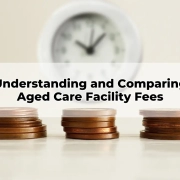How does the Australian government support aged care?
Table of Contents
ToggleAs our population continues to age, the importance of quality aged care services becomes increasingly significant. Navigating the world of aged care can be complex, but fortunately, the Australian government is dedicated to providing support through various subsidies and programs.
In this blog post, we’ll break down how the Australian government supports aged care, making it easier for you to understand the options available to you or your loved ones. From subsidies that make costs more manageable to different care programs, we’ll explore the ways in which the government aims to ensure accessible and affordable aged care services for all.
Government subsidies for aged care services
One of the pillars of Australia’s commitment to providing excellent aged care is the range of government subsidies designed to make these services more accessible and affordable. These subsidies are like financial assistance from the government to help cover the costs associated with different types of aged care options. This is how the Australian government supports aged care. They play a crucial role in ensuring that individuals have choices when it comes to receiving the care they need as they age.
There are three main subsidy programs that the Australian government offers:
Commonwealth Home Support Programme (CHSP)
The Commonwealth Home Support Programme, or CHSP, is tailored for older individuals who have lower care needs but still require assistance to continue living comfortably in their own homes. This program provides basic support services that can include things like help with housework, transportation, and personal care. By offering these services, the CHSP aims to help older Australians maintain their independence and quality of life.
Home Care Package Program
For those with varying levels of care needs, the Home Care Package Program steps in. This program offers four different levels of subsidies, each catering to specific care requirements. The idea is to customise the care to match the individual’s needs, allowing them to stay in their own homes while receiving the necessary support. This could include services like nursing care, therapy, and help with daily tasks, all of which contribute to a higher quality of life.
Home Care Packages come in four levels, and each level offers a different subsidy rate (effective from 1 July 2023):
| Home Care Package Level | Daily Subsidy Rate | Yearly Subsidy Rate |
|---|---|---|
| Level 1 - Basic Care Needs | $28.14 | $10,271 |
| Level 2 - Low-level Care Needs | $49.49 | $18,064 |
| Level 3 - Intermediate Care Needs | $107.70 | $39,311 |
| Level 4 - High-level Care Needs | $163.27 | $59,594 |
Aged Care Home Subsidies
For individuals who require more intensive care in a residential setting, Aged Care Home subsidies come into play. These subsidies help offset the costs associated with living in an aged care facility. It’s important to note that not all aged care homes are eligible for these subsidies, and specific criteria need to be met. However, for those who do qualify, these subsidies can significantly reduce the financial burden of receiving specialised care in a residential environment.
These government subsidies are designed with the goal of providing options and easing the financial strain that can come with aged care services. By understanding the programs available, individuals and families can make informed decisions about the care that best suits their needs and preferences. Whether it’s staying in the comfort of their own home or receiving care in a specialised facility, these subsidies are a crucial part of Australia’s commitment to supporting its ageing population.

Private Aged Care Housing Options
In addition to government-funded aged care providers, there are also private aged care housing options available. These private options operate separately from government-subsidised facilities and offer a different avenue for individuals seeking aged care services.
What are private aged care housing options?
Private aged care housing refers to facilities that are funded by private individuals or organisations rather than the government. These options often come with a wider range of services and amenities, providing a more personalised and luxurious experience for residents. While government-funded facilities prioritise accessibility and affordability, private options cater to those who are looking for extra services and are willing to invest in a more tailored experience.
Key distinctions between government-funded and private options
Services and Amenities
Private options tend to offer a variety of enhanced services beyond the basic care that government-subsidised facilities provide. These can include amenities such as spa treatments, gourmet dining, and various recreational activities.
Customization
Private facilities often allow residents to customise their care plans to a greater extent. This means that individuals can choose services that align with their preferences and needs, creating a more personalised care experience.
Accommodation
Private facilities often offer different types of accommodation, ranging from standard rooms to private suites. This level of choice allows individuals to select living arrangements that suit their comfort and lifestyle.
When considering private aged care housing options, it’s essential to weigh the benefits against the costs. While these facilities offer an array of amenities and personalised services, they generally come with a higher price tag due to the increased level of luxury and customization.
Before making a decision, take the time to thoroughly research the private facilities available in your area. Compare their services, amenities, costs, and reviews to ensure that you’re choosing an option that aligns with your needs and budget. Transparency and clear communication are key during this process, ensuring that you have a full understanding of what each facility offers and what you’ll be investing in.

Eligibility and Cost Breakdown
Understanding the eligibility criteria and costs associated with aged care services is crucial when planning for yourself or a loved one’s future care needs. Here, we’ll break down the basics to help you navigate this important aspect of aged care.
Eligibility for government-supported Aged Care Homes
To be eligible for government-subsidised care in Aged Care Homes, certain criteria need to be met. These criteria usually revolve around an individual’s inability to live independently due to health or mobility issues, or the need for specialised care. A comprehensive assessment is conducted to determine the level of care required and whether the individual meets the eligibility criteria for government assistance.
Basic Fee and Accommodation Costs
When it comes to the costs of aged care services, there are a few key elements to consider:
Basic Fee
This fee covers a portion of the care provided and is set by the government. It’s determined based on an individual’s income and assets. Everyone receiving government-supported aged care is required to pay this fee. The maximum basic daily fee in residential care, as of 20 September 2024, is currently $63.57 and you can make a direct transfer of this fee from your pension.
Accommodation Costs
Accommodation costs vary depending on the type of room or living arrangement chosen. These costs cover the physical space and infrastructure of the aged care facility. The Australian government offers options to help cover these costs, such as the Age Pension, or individuals can choose to pay privately.
Additional payments for enhanced services
In addition to the basic fee and accommodation costs, individuals might opt for extra services that go beyond the standard care. These could include amenities like newspapers, entertainment subscriptions, or special outings. These services come with additional charges, and it’s important to understand what’s included in the package and what falls under these optional extras.
A clear understanding of the services provided and associated costs is vital to making informed decisions. When exploring aged care options, make sure to ask questions and seek transparent information from the facility or service provider. This will help you avoid any unexpected surprises and allow you to plan your finances effectively.

Navigating the landscape of aged care services involves understanding the various government subsidies, eligibility criteria, costs, and additional service options. Ultimately, the goal of aged care support is to provide comfort, quality of life, and a sense of security during this important stage.








